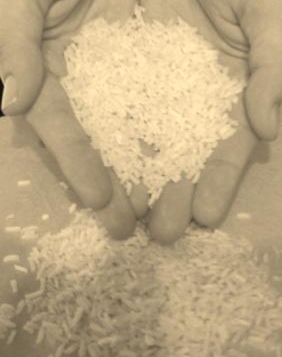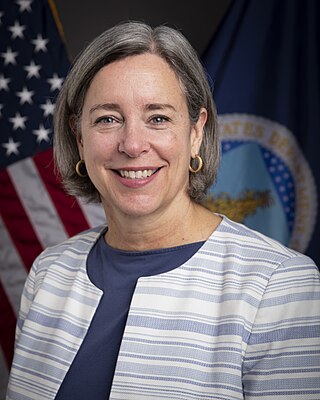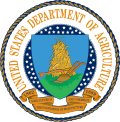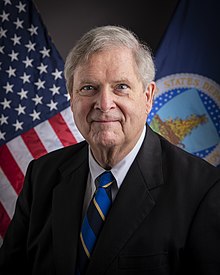
The United States Department of Agriculture (USDA) is an executive department of the United States federal government that aims to meet the needs of commercial farming and livestock food production, promotes agricultural trade and production, works to assure food safety, protects natural resources, fosters rural communities and works to end hunger in the United States and internationally. It is headed by the secretary of agriculture, who reports directly to the president of the United States and is a member of the president's Cabinet. The current secretary is Tom Vilsack, who has served since February 24, 2021.

Ann Margaret Veneman is an American attorney who served as the fifth executive director of UNICEF from 2005 to 2010. She previously served as the 27th United States secretary of agriculture from 2001 to 2005. Veneman served for the entire first term of President George W. Bush, and she left to take the UNICEF position. Appointed by the U.N. Secretary-General Kofi Annan on January 18, 2005, she took over the post on May 1, 2005. A lawyer, Veneman has practiced law in Washington, DC and California, including being a deputy public defender. She has also served in other high-level positions in both the state and the federal government of the United States, including being appointed secretary of the California Department of Food and Agriculture, serving from 1995 to 1999, as well as United States deputy secretary of agriculture, serving from 1991 to 1993. Throughout her public career, Veneman was the first woman to serve in a number of positions, including secretary of agriculture, deputy secretary of agriculture, and California's secretary of food and agriculture. She was also just the second woman to lead UNICEF, following her predecessor, Carol Bellamy.

In the United States, the Supplemental Nutrition Assistance Program (SNAP), formerly known as the Food Stamp Program, is a federal government program that provides food-purchasing assistance for low- and no-income people to help them maintain adequate nutrition and health. It is a federal aid program administered by the U.S. Department of Agriculture (USDA) under the Food and Nutrition Service (FNS), though benefits are distributed by specific departments of U.S. states.

Electronic benefit transfer (EBT) is an electronic system that allows state welfare departments to issue benefits via a magnetically encoded payment card used in the United States. It reached nationwide operations in 2004. The average monthly EBT payout is $230 per participant as of 2022.

The Food and Nutrition Service (FNS) is an agency of the United States Department of Agriculture (USDA). The FNS is the federal agency responsible for administering the nation’s domestic nutrition assistance programs. The service helps to address the issue of hunger in the United States.

Food policy is the area of public policy concerning how food is produced, processed, distributed, purchased, or provided. Food policies are designed to influence the operation of the food and agriculture system balanced with ensuring human health needs. This often includes decision-making around production and processing techniques, marketing, availability, utilization, and consumption of food, in the interest of meeting or furthering social objectives. Food policy can be promulgated on any level, from local to global, and by a government agency, business, or organization. Food policymakers engage in activities such as regulation of food-related industries, establishing eligibility standards for food assistance programs for the poor, ensuring safety of the food supply, food labeling, and even the qualifications of a product to be considered organic.
The Under Secretary for Food, Nutrition, and Consumer Services is a position created within the United States Department of Agriculture in 1993, and is responsible for administrating the department's fifteen nutrition and food security programs and for promoting the dietary guidelines. <7 CFR § 2.19> The food assistance programs have a combined budget of $170.5 billion and include the Food Stamp Program, the Special Supplemental Nutrition Program for Women, Infants and Children, the National School Lunch and School Breakfast Programs, and the Commodity Distribution Programs. In addition, the Undersecretary oversees the Center for Nutrition Policy and Promotion, which leads the development of dietary guidelines and which promotes the guidelines through the Food Guide Pyramid (MyPyramid.gov).
Nutrition Assistance for Puerto Rico (NAP) —Spanish: Programa de Asistencia Nutricional (PAN) popularly known in Puerto Rico as Cupones — is a federal assistance nutritional program provided by the United States Department of Agriculture (USDA) solely to Puerto Rico. In 2021, over $2 billion USD was appropriated as a block grant for NAP to assist over 1 million impoverished residents of Puerto Rico. It is based on, though not part of, the USDA's national Supplemental Nutrition Assistance Program (SNAP) which in 2018 provided $64 billion in nutritional assistance to 42 million people in the 50 U.S. states, D.C., Guam and the US Virgin Islands.
The Child and Adult Care Food Program (CACFP) is a type of United States federal assistance provided by the Food and Nutrition Service (FNS) of the United States Department of Agriculture (USDA) to states in order to provide a daily subsidized food service for an estimated 3.3 million children and 120,000 elderly or mentally or physically impaired adults in non-residential, day-care settings. It is a branch within the Policy and Program Development Division of the Child nutrition programs, along with the School Programs Branch, which runs the National School Lunch Program. The program is commonly referred to as the Child Care, Child Care Food, Adult Care, or Adult Care Food Program, and is often operating in conjunction with other child and adult day-care programs, such as the Head Start. Its federal identification number, or CFDA number, is 10.558. Section 17 of the National School Lunch Act, and USDA issues the program regulations under 7 CFR part 226.
Executive Schedule is the system of salaries given to the highest-ranked appointed officials in the executive branch of the U.S. government. The president of the United States appoints individuals to these positions, most with the advice and consent of the United States Senate. They include members of the president's Cabinet, several top-ranking officials of each executive department, the directors of some of the more prominent departmental and independent agencies, and several members of the Executive Office of the President.
The Under Secretary for Research, Education, and Economics is a high-ranking official within the United States Department of Agriculture that provides leadership and oversight for the Agricultural Research Service, National Institute of Food and Agriculture, Economic Research Service, National Agricultural Library, National Agricultural Statistics Service.

Eric Michael Bost is the former United States Ambassador to South Africa. He was sworn in as U.S. Ambassador to the Republic of South Africa by President George W. Bush on July 20, 2006, after being confirmed by the U.S. Senate on June 29. Bost presented his credentials to South African President Thabo Mbeki on August 15, 2006. He completed his tour as ambassador on January 20, 2009.
The New York City Coalition Against Hunger (NYCCAH) is a nonprofit organization, which aims to “enact innovative solutions to help society move ‘beyond the soup kitchen’ to ensure economic and food self-sufficiency for all Americans”. NYCCAH works collaboratively with local, state, and national legislatures as well as New York residents and community associations. In contrast to other organizations, NYCCAH generally does not distribute food but rather concerns itself with providing technical assistance to groups which do while simultaneously affecting hunger policy at a more macro-urban scale.

Catherine E. Woteki was the under secretary for United States Department of Agriculture's (USDA) Research, Education, and Economics (REE) mission area, as well as the department's chief scientist. Her responsibilities included oversight of the four agencies that comprise REE, the Agricultural Research Service (ARS), National Institute of Food and Agriculture (NIFA), Economic Research Service (ERS), and National Agricultural Statistics Service (NASS.) The National Agriculture Library and National Arboretum also fall under this mission area. Since 2021, she has been a member of the President’s Council of Advisors on Science and Technology (PCAST).

CalFresh is the California implementation of the federal Supplemental Nutrition Assistance Program (SNAP), formerly known as the Food Stamp program, which provides financial assistance for purchasing food to low-income California residents.

The Agriculture, Rural Development, Food and Drug Administration, and Related Agencies Appropriations Act, 2015 is an appropriations bill for fiscal year 2015 that would provide funding for the United States Department of Agriculture and related agencies. The bill would appropriate $20.9 billion.

For the American singer-songwriter, author, and TV host, see Stacy Dean Campbell.

























































